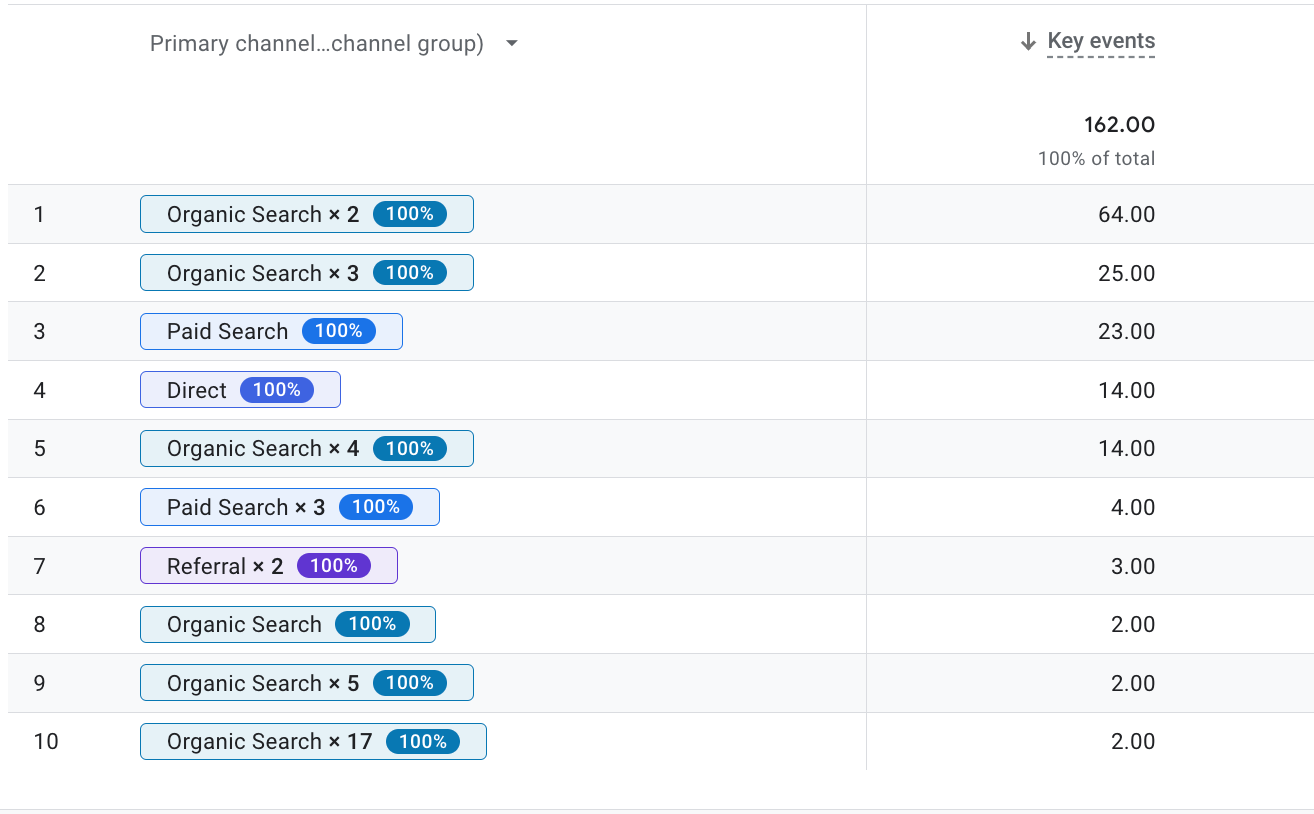Understanding the impact of pausing ads:
a case study.
When a long-term client of ours paused their Google Ads unexpectedly, we observed some startling consequences: a 50% drop in overall traffic, a 93% decrease in new contacts from direct traffic, and a complete halt in new customer acquisitions.
This case study highlights the importance of a multi-channel strategy, demonstrating the very real and detrimental impact on all channels, including organic, when paid ads are switched off. Conversely, the data clearly shows that running paid ads can provide a crucial foundation for all acquisition channels.
Understanding this is crucial for B2B companies, where multiple touch points and ever-lengthening sales cycles are involved before conversion.
decrease contacts from direct traffic.
decrease in email marketing sessions.
decrease in organic social sessions.
The challenge
In today's digital landscape, users frequently navigate between platforms such as Meta, Google Ads, LinkedIn, and TikTok, often revisiting these platforms multiple times. This raises a crucial question: can we truly measure platform-specific Return on Ad Spend (ROAS)?
Determining the Most Effective Channel:
How can we ascertain which channel brings the most leads and where to invest more? The truth is, we can't know for certain. The customer journey is becoming increasingly complex, making it difficult to attribute a lead to a single channel accurately. As marketers, we are data-driven and strive to clearly identify what works and what doesn't.
Moreover, we discovered that turning off one channel (Google Ads) negatively impacted other channels as well. The decline in performance affected all channels, underscoring the importance of a multi-channel strategy that doesn't neglect any platform.

Adopting a Multi-Channel Perspective:
However, we need to start evaluating our results without focusing solely on which channel produced them. Understanding the importance of a multi-channel strategy reveals results from multiple sources without attributing success to one channel or blaming another.
GA4 Insights:
Google Analytics 4 (GA4) offers an excellent reporting tool that illustrates how users interact with our site and how various channels influence them at different times before they decide to contact us.
By navigating to Advertising > Attribution Paths, you can access the Conversion Paths report. This report shows the sequence of user interactions before converting and indicates how many times a user interacted with the website via a specific channel before converting.
Example Scenario:
Consider a user who first encounters your brand through Organic Search, interacting three times, then researches your products again on Google and clicks on your Google Ads twice, followed by another interaction via Organic Search. Should Organic Search receive full attribution? It's a complex question. Google Ads may have significantly influenced the user's purchase intent.

A multi-channel strategy is therefore essential for business success because it ensures that a company can effectively reach and engage with its audience through multiple platforms, such as paid advertising, organic search, social media, and email marketing. All channels are important touch points for users, and excluding one channel can have consequences on all other channels.
For example, when paid ads are switched off, the impact is not limited to just the paid channel but ripples across all channels. The reduction in visibility and engagement from paid ads can lead to a noticeable decline in organic search rankings, social media interactions, and overall customer reach, highlighting the critical importance of a diversified, multi-channel approach to marketing.
Case Study: the impact of pausing ads
Clients often contemplate turning off ads for various reasons. They may believe the ads aren't generating quality leads or a sufficient number of leads. There's also a common expectation that results will be immediate, with leads converting right away, without considering conversion time. Additionally, high cost-per-click (CPC) rates can discourage them from investing in paid ads.
However, the data below shows that paid ads are a fundamental part of a B2B business strategy. Even if they don't deliver immediate results, turning them off can have an immediate and negative impact. This highlights the importance of maintaining a consistent paid advertising strategy for long-term success.
7 days of active ads
Below, HubSpot's traffic report shows that in only seven days, one of our client gained a total of 124 contacts across all channels and converted 3 of them into customers.
.png?width=2000&height=1125&name=DMS%20Videos%20(8).png)
7 days of paused ads
After switching off the ads, the client experienced a drastic drop in sessions and contacts across all channels, as shown on the report below.
.png?width=2000&height=1125&name=DMS%20Videos%20(9).png)
By comparing data from when Google Ads were active to when they were paused, we found the following:
- Overall traffic down by 50%
- Direct traffic contacts down by 93%
- Customers down from 3 to 0
- Organic Social traffic down by 94%
- Email marketing traffic down by 41%
Key takeaways:
- Long-Term Success: Consistent paid advertising is crucial for long-term business success, even if immediate results are not evident. Paid ads are a non-negotiable, critical part of your digital strategy.
- Complex Customer Journey: It is challenging to attribute leads to a single channel due to the increasingly complex customer journey.
- Interconnected Channel Performance: Turning off one channel (e.g., Google Ads) negatively affects the performance of other channels, emphasising the need for a multi-channel strategy.
Related Case studies
/AppogeeHR.png)



